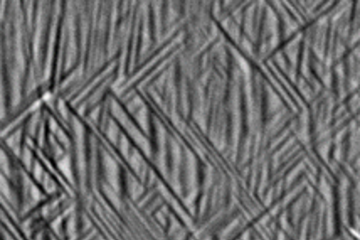All genres
101.
Journal Article
Spatially resolved high sensitive measurement of hydrogen permeation by scanning Kelvin probe microscopy. Electrochimica Acta 110, pp. 534 - 538 (2013)
102.
Journal Article
Corrosion performance of Zn–Mg–Al coated steel in accelerated corrosion tests used in the automotive industry and field exposures. Materials and Corrosion-Werkstoffe und Korrosion 64 (11), pp. 969 - 978 (2013)
103.
Journal Article
Monitoring surface ion mobility on aluminum oxide: Effect of chemical pretreatments. Electrochimica Acta 110, pp. 526 - 533 (2013)
104.
Journal Article
Redox responsive release of hydrophobic self-healing agents from polyaniline capsules. Journal of the American Chemical Society 135 (38), pp. 14198 - 14205 (2013)
105.
Journal Article
Electro-codeposition of modified silica colloids and copper. Zeitschrift für physikalische Chemie 227 (8), pp. 1083 - 1095 (2013)
106.
Journal Article
Effect of carbon dioxide on the atmospheric corrosion of Zn–Mg–Al coated steel. Corrosion Science 74, pp. 379 - 386 (2013)
107.
Journal Article
A novel laboratory set-up for investigating surface and interface reactions during short term annealing cycles at high temperatures. Review of Scientific Instruments 84, 085108 (2013)
108.
Journal Article
Influence of an atom in EGaIn/Ga2O3 tunneling junctions comprising self-assembled monolayers. Journal of Physical Chemistry C 117 (21), pp. 11367 - 11376 (2013)
109.
Journal Article
Theoretical Efficiency of Metallic Dispersion Coatings for Corrosion Protection at the Cut-Edge. Journal of the Electrochemical Society 160 (8), pp. C305 - C315 (2013)
110.
Journal Article
Role of surface oxide properties on the aluminum/epoxy interfacial bonding. The Journal of Physical Chemistry C 117 (9), pp. 4480 - 4487 (2013)
111.
Journal Article
Modulation of electrochemical hydrogen evolution rate by araliphatic thiol monolayers on gold. Electrochimica Acta 90, pp. 17 - 26 (2013)
112.
Journal Article
Structure and volta potential of lipid multilayers: Effect of X-ray irradiation. Langmuir 29 (2), pp. 815 - 824 (2013)
113.
Journal Article
Hydrogen detection in metals: A review and introduction of a Kelvin probe approach. Science and Technology of Advanced Materials 14 (1), 014201 (2013)
114.
Journal Article
Third-order effects in resonant sum-frequency-generation signals at electrified metal/liquid interfaces. Journal of the Optical Society of America B-Optical Physics 30 (1), pp. 219 - 223 (2013)
115.
Journal Article
The influence of halides on the initial selective dissolution of Cu3Au (111). Electrochimica Acta 85, pp. 384 - 392 (2012)
116.
Journal Article
Cathodic self-healing at cut-edges: The effect of Zn2+ and Mg2+ ions. Corrosion Science 65, pp. 119 - 127 (2012)
117.
Journal Article
Existence of a lower critical radius for incorporation of silica particles into zinc during electro-codeposition. ACS Applied Materials and Interfaces 4 (11), pp. 6221 - 6227 (2012)
118.
Journal Article
Combined high resolution scanning Kelvin probe - Scanning electrochemical microscopy investigations for the visualization of local corrosion processes. Electrochimica Acta 82, pp. 339 - 348 (2012)
119.
Journal Article
The hydrogen electrode in the “dry”: A Kelvin probe approach to measuring hydrogen in metals. Electrochemistry Communications 24, pp. 85 - 88 (2012)
120.
Journal Article
Hydrogen as an optimum reducing agent for metallization of self-assembled monolayers. Journal of Materials Chemistry 22 (29), pp. 14337 - 14340 (2012)











